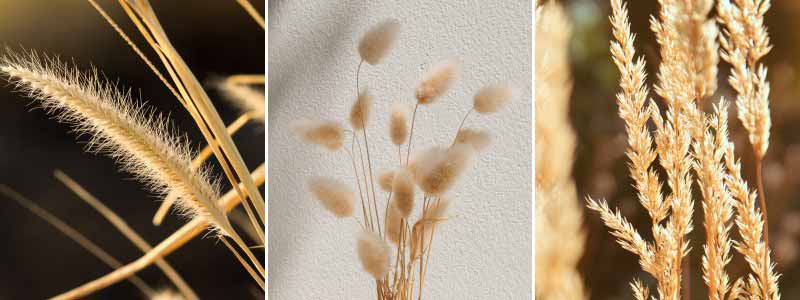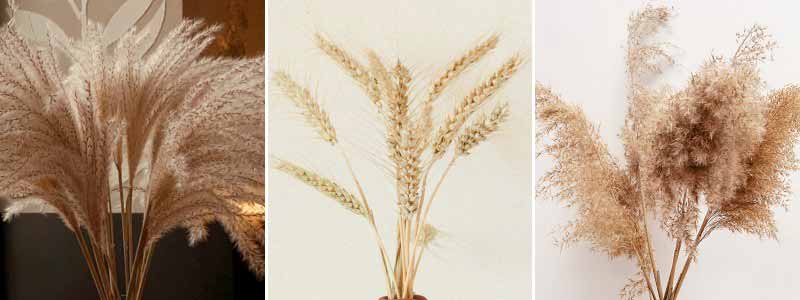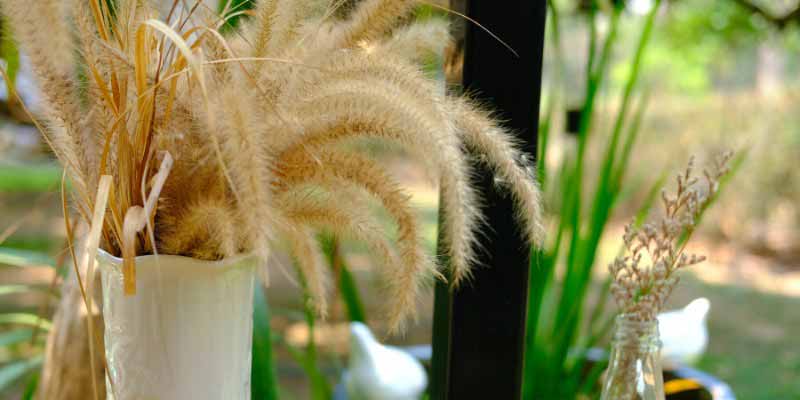Ornamental grasses or Poaceae are highly sought after for adding movement, naturalness, and brightness to the garden. They have a unique way of catching the light. With their quivering silhouette that undulates at the slightest breeze, they are essential for bringing a wild yet structured aspect to all gardens. In recent years, they have escaped gardens to invade our interiors, adding a graphic and natural touch. Want to extend their life by drying them? Discover which grasses are best suited and how to dry them!
Which grasses to dry?
Choose robust species that hold up well after picking, such as Pennisetum or Miscanthus, which feature beautiful inflorescences. They often add a lot of softness to a dried bouquet. These grasses are not only aesthetic but also resistant to desiccation, making them ideal for interior decoration. It is crucial to select grasses that retain their beautiful blonde or golden hues and their shape once dried for optimal results. Here are some varieties of grasses that lend themselves well to drying:
- Pennisetum, or Fountain Grass, is an excellent choice with its feathery spikes resembling small brushes or the fluffy tail of a rabbit. They come in cream to silver, bronze-yellow, brown-black (Pennisetum alopecuroides ‘Moudry’), pink-beige, or even purplish pink (Pennisetum orientale ‘Karley Rose’). These fluffy rabbit tails help soften a bouquet.
- In the same spirit, the Lagurus ovatus 'Bunny Tails', or Dwarf Hare's Tail, is a small grass with small oval and villous spikes that have a texture as soft as a rabbit's paw.
- Calamagrostis and notably Calamagrostis brachytricha whose flowers resemble beige-pink then silver plumes.

- Melica ciliata or Ciliated Melica produces graceful silky and graphic flower spikes in a very bright beige.
- Miscanthus whose flowering takes the form of light silky spikelets with golden, silver, brown, or pink reflections. The Chinese Reed allows for beautiful dried bouquets.
- 'Hordeum jubatum or Foxtail Barley, which offers green spikes that turn beige when dry, resembling wheat spikes.
- Pampas grass or Cortaderia : impossible to overlook this grass that has been trendy in our interiors for years! It is one of the most decorative grasses, but undoubtedly also the most invasive in the garden! In France, it has officially been added to the list of invasive plants that can no longer be sold since April 2023. It is now illegal to produce and sell Pampas Grass. It can be replaced by the grasses mentioned above, all equally graphic but non-invasive.

When to pick grasses for drying?
The best time to pick grasses is generally in late summer or early autumn, at the end of flowering. Prefer to harvest on a warm day and after the dew has dissipated. This allows for stems and leaves that are less waterlogged, thus facilitating the drying process. Remove damaged flowers and leaves to limit evapotranspiration and aid preservation. Using clean pruning shears, cut the stems to the desired length.
How to dry grasses?
There are several drying methods for creating dried grass bouquets. We suggest the simplest and most economical techniques.
Air drying
This natural technique involves drying your grass stems upside down.
- Cut the stems, leaving about 15 cm of extra length for the bouquet
- Bind them into small bouquets of five to ten stems using raffia or string
- Hang them upside down in a dry, dark, and well-ventilated place. A garage, attic, or cupboard can be perfect.
- Ensure they are well spaced to allow good air circulation around each bouquet. It is important to regularly check the drying rate. Air circulation helps to dry the inflorescences well, and darkness preserves their colours. Sunlight alters the hue of the flowers, which may fade. Drying time varies, but expect about two to three weeks.
In a vase
You can also dry your grasses simply by placing them in a vase. You can use glycerin, although it is not essential. This ingredient helps prevent the stems and flowers from becoming too brittle and keeps some flexibility.
- Select a tall, narrow vase to allow good air circulation around the stems
- Place the cut grasses in the vase without water
- Leave them in a dark, dry, and well-ventilated room for them to dry naturally.

With glycerin:
- Pour 1/3 glycerin into 2/3 boiling water in a bowl, whisk to obtain a homogeneous mixture.
- Let the mixture cool, then pour it into the vase
- Simply place your bouquet in the vase
- Gradually, glycerin will replace the sap contained in the stems. On average, with or without glycerin, you will need to wait between two and four weeks to eliminate all the water contained in the stems and flowers.
What to do to maintain and preserve dried grasses?
To maintain the colour, avoid exposing them directly to sunlight. Keep the grasses in a place protected from direct light and moisture. A light spray of hairspray can help protect them from ambient dust. To dust them, you can give them a gentle blast from a hairdryer. Dried flowers are quite fragile. It is best to handle them gently if you wish to move them or change the vase of the dried bouquet.
How to compose a dried bouquet?
Feel free to mix different species together, varying the sizes and shapes of the inflorescences. Dried grasses also pair well with other dried flowers such as lavender, roses, or even everlastings. You can even incorporate elements like pine cones or twigs for an even more natural look.
































Comments